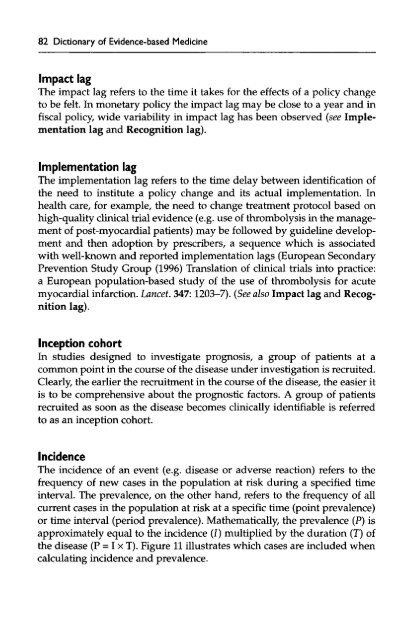Dictionary of Evidence-based Medicine.pdf
Dictionary of Evidence-based Medicine.pdf
Dictionary of Evidence-based Medicine.pdf
Create successful ePaper yourself
Turn your PDF publications into a flip-book with our unique Google optimized e-Paper software.
82 <strong>Dictionary</strong> <strong>of</strong> <strong>Evidence</strong>-<strong>based</strong> <strong>Medicine</strong><br />
Impact lag<br />
The impact lag refers to the time it takes for the effects <strong>of</strong> a policy change<br />
to be felt. In monetary policy the impact lag may be close to a year and in<br />
fiscal policy, wide variability in impact lag has been observed (see Implementation<br />
lag and Recognition lag).<br />
Implementation lag<br />
The implementation lag refers to the time delay between identification <strong>of</strong><br />
the need to institute a policy change and its actual implementation. In<br />
health care, for example, the need to change treatment protocol <strong>based</strong> on<br />
high-quality clinical trial evidence (e.g. use <strong>of</strong> thrombolysis in the management<br />
<strong>of</strong> post-myocardial patients) may be followed by guideline development<br />
and then adoption by prescribers, a sequence which is associated<br />
with well-known and reported implementation lags (European Secondary<br />
Prevention Study Group (1996) Translation <strong>of</strong> clinical trials into practice:<br />
a European population-<strong>based</strong> study <strong>of</strong> the use <strong>of</strong> thrombolysis for acute<br />
myocardial infarction. Lancet. 347:1203-7). (See also Impact lag and Recognition<br />
lag).<br />
Inception cohort<br />
In studies designed to investigate prognosis, a group <strong>of</strong> patients at a<br />
common point in the course <strong>of</strong> the disease under investigation is recruited.<br />
Clearly, the earlier the recruitment in the course <strong>of</strong> the disease, the easier it<br />
is to be comprehensive about the prognostic factors. A group <strong>of</strong> patients<br />
recruited as soon as the disease becomes clinically identifiable is referred<br />
to as an inception cohort.<br />
Incidence<br />
The incidence <strong>of</strong> an event (e.g. disease or adverse reaction) refers to the<br />
frequency <strong>of</strong> new cases in the population at risk during a specified time<br />
interval. The prevalence, on the other hand, refers to the frequency <strong>of</strong> all<br />
current cases in the population at risk at a specific time (point prevalence)<br />
or time interval (period prevalence). Mathematically, the prevalence (P) is<br />
approximately equal to the incidence (/) multiplied by the duration (T) <strong>of</strong><br />
the disease (P = I x T). Figure 11 illustrates which cases are included when<br />
calculating incidence and prevalence.










